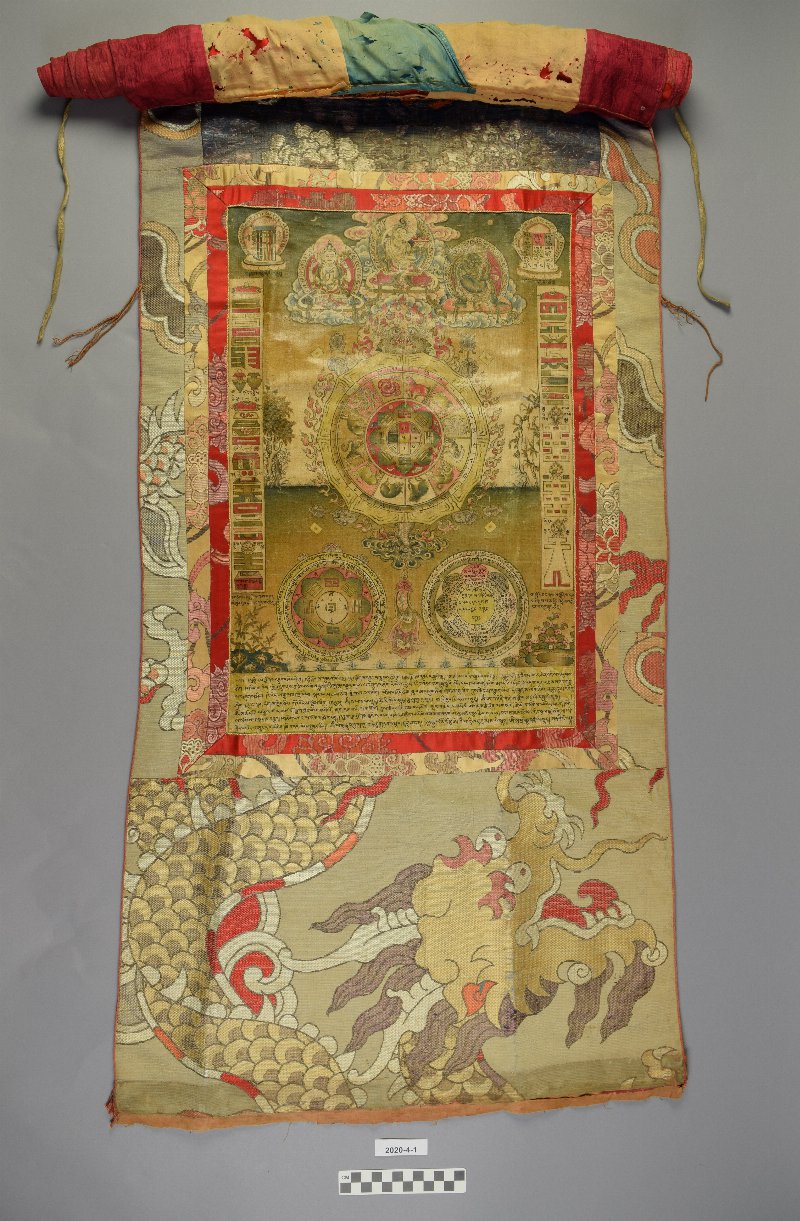Thangka
2020-4-1
From: Mongolia (uncertain) | Tibet (uncertain)
Curatorial Section: Asian
| Object Number | 2020-4-1 |
| Current Location | Collections Storage |
| Culture | Buddhist |
| Provenience | Mongolia (uncertain) | Tibet (uncertain) |
| Date Made | 19th - early 20th century CE |
| Section | Asian |
| Materials | Silk | Canvas |
| Iconography | Manjusri | Avalokitesvara | Vajrapani | Rubal | Tortoise | Bagua | Kalachakra Monogram |
| Inscription Language | Tibetan Language |
| Description | Mongolian or Tibetan astrological thangka in the form of a protective talisman chart (Srid pa ho). The center features a yellow tortoise, Rubal, as the emanation of the bodhisattva of knowledge, Manjusri. The tortoise is depicted on its back holding impaled frogs. Its belly contains various diagrams and symbols. The most central diagram is made up of nine magic numbers in colored squares surrounded by the eight trigrams (bagua). This is encircled by a red border containing the symbols of the eight planets (clockwise from the top): Mars (an eye), Saturn (bundle), Venus (arrow), Mercury (hand), the crescent Moon, Jupiter (kila), Rahu (a bird's head), and the Sun. The twelve animals of the sixty year cycle surround this central circle. At the top center is Manjusri identified by the sword in the right hand and a sutra text in the left. On the right is Vajrapani in green holding a vajra and on the right is Chenrezig (Avalokitesvara) in white, holding prayer beads, a willow branch, and a jewel. In the upper left corner there is the symbol of the ten stacked syllables of the Kalachakra (Tibetan: nam chu wang den) atop a lotus flower base. The upper right corner contains a magic square on a lotus base containing prayers. Both sides of the painting feature banners with various auspicious symbols. The bottom half contains two mandalas containing lotus flowers with writing. The one of the left is held by Rubal, the tortoise and the one on the right is filled with mantras for protection. A banner between them has a fish, conch shell, and winged creature on it. The bottom contains a block of text on a yellow floral background. The entire painting is backed with silk of various patterns with the largest portion featuring a dragon. The back of the painting has Tibetan text identifying the three deities at the top followed by a lengthy inscription. There is a print of a vajra on the bottom right and printed text on the bottom left. The thangka also has a cover of blue, yellow, and red silk which has been damaged. |
| Length | 100 cm |
| Width | 55 cm |
| Credit Line | Gift of Christopher P. Atwood, 2020 |
Report problems and issues to digitalmedia@pennmuseum.org.




